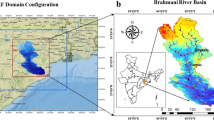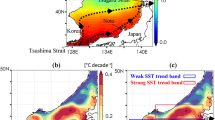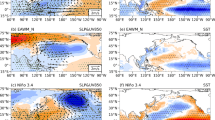Abstract
Jawad, an anomalous post-monsoon tropical cyclone (TC) that originated over the Bay of Bengal (BoB), renewed the challenges encountered in forecasting TCs by operational agencies, as the TC behaved contrarily in terms of predicted track and intensity. The novelty of this study is, for the first time, the impacts of the regional coastal land and ocean processes along with large-scale features are comprehensively examined that are regulated by the TC characteristics with thrust on its track and intensity. A total of four experiments, i.e., two Land Use Land Cover (LULC) datasets, viz., (1) United States Geological Survey (USGS), and (2) Indian Space Research Organization (ISRO) Advanced Wide Field Sensor (AWiFS) and two sea surface temperature (SST) datasets (i.e., INCOIS and default GFS) are tested to investigate the coastal processes using the Weather Research and Forecasting (WRF) model at a horizontal resolution of 3 km. The simulations are carried out with a lead time up to 96 h. Results suggested that ISRO LULC along with default SST experiment named as ISR (INCOIS SST and ISRO LULC named as INS) has the highest (lowest) forecast skills, i.e., track, intensity and precipitation. The vertical structures of specific humidity and the location of the updraft in ISRO LULC are associated with an accurate representation of latent heat flux (LHF) near the coast, enabling better intensity estimates of the cyclone. On the contrary, the overestimation of LHF led to the overestimation of intensity in INS. The results also highlighted that the land–atmospheric coupling index and storm energetics are better represented by ISR to support the realistic modulation of the intensification and associated convective processes. Interestingly, it is also noted that the effect of LULC on the energy exchanges between the surface and lower atmosphere in the coastal region is overridden by the effect of SST leading to poor results for INC (INCOIS SST and USGS LULC); therefore, choice of appropriate combination of LULC and SST is equally important for better forecast skills. This study demonstrates that an optimal combination of region-specific LULC and SST data is essential for accurate cyclone intensity prediction, particularly near the coastal region.

















Similar content being viewed by others
Data availability
The datasets generated during and/or analyzed during the current study are available from the corresponding author on reasonable request.
References
Anderson JR, Hardy EE, Roach JT, Witmer RE (1976) A land use land cover classification system for use with remote sensor data. USGS Pub Wareh. https://doi.org/10.3133/pp964
Badrinath KVS, Mahalakshmi DV, Ratna SB (2012) Influence of land use land cover on cyclone track prediction. A study during Alia cyclone. The Open Atm Sci J 6:33–41. https://doi.org/10.2174/1874282301206010033
Baisya H, Pattnaik S, Chakraborty T (2020) A coupled modeling approach to understand ocean coupling and energetics of tropical cyclone in Bay of Bengal basin. Atmos Res 246:105092. https://doi.org/10.1016/j.atmosres.2020.105092
Barik S (2021) Odisha to give ₹507 cr. aid for crop loss due to Cyclone Jawad. The Hindu. https://www.thehindu.com/news/national/other-states/odisha-to-give-507-cr-aid-for-crop-loss-due-to-cyclone-jawad
Basiya H, Pattnaik S, Rajesh PV (2017) Land surface-precipitation feedback analysis for a landfalling monsoon depression in the Indian region. J Adv Model Earth Syst 9:712–726. https://doi.org/10.1002/2016MS000829
Betts AK (2004) Understanding hydrometeorology using global models. Bulletin Amer Meteorol Society 85(11):1673–1688. https://doi.org/10.1175/BAMS-85-11-1673
Betts AK, Ball JH, Beljaars ACM, Miller MJ, Viterbo PA (1996) The land-surface atmosphere interaction: a review based on observational and global modeling perspectives. J Geophys Res 101(B):7209–7225. https://doi.org/10.1029/95JD02135
Biswadip G (2014) IRS-P6 AWiFS derived gridded land use/land cover data compatible to mesoscale models (MM5 and WRF) over Indian Region. NRSC Technical Document. NRSC-ECSA-ACSG-OCT-2014-TR-651
Chakraborty T, Pattnaik S, Baisya H, Vishwakarma V (2022) Investigation of ocean sub-surface processes in tropical cyclone Phailin using a coupled modeling framework: Sensitivity to ocean conditions. Oceans 3:364–388. https://doi.org/10.3390/oceans3030025
Chan KTF, Chan JCL (2016) Sensitivity of the simulation of tropical cyclone size to microphysics schemes. Adv Atmos Sci 33:1024–1035. https://doi.org/10.1007/s00376-016-5183-2
Choudhary D, Das S (2017) The sensitivity of microphysical schemes on the skill of forecasting the track and intensity of tropical cyclone using WRF-ARW model. J Earth Syst Sci 126:57. https://doi.org/10.1007/s12040-017-0830-2
Dimri AP, Niyogi D, Barros AP, Ridley J, Mohanty UC, Yasunari T, Sikka DR (2015) Western disturbances: a review. Rev Geophys 53:225–246. https://doi.org/10.1002/2014RG000460
Dudhia J (1989) Numerical study of convection observed during winter monsoon experiment using a mesoscale two-dimensional model. J Atmos Sci 46:3077–3107
Dutton JA (1976) The ceaseless wind: an introduction to theory of atmospheric motion. Mc-Graw-Hill, New York
Duveiller G, Hooker J, Cescatti A (2018) The mark of vegetation change on Earth’s surface energy balance. Nat Commun 9(1):679. https://doi.org/10.1038/s41467-017-02810-8
Eltahir AB (1998) A soil moisture-rainfall feedback mechanism:1. Theory Observat Water Resour Res 34(4):765–776
Emanuel KA (1986) An air-sea interaction theory for tropical cyclones. Part I: steady-state maintenance. J Atmos Sci 43:585–605
Findell KL, Berg A, Gentine P, Krasting JP, Lintner BR, Malyshev S, Santanello JA Jr, Shevliakova E (2017) The impact of anthropogenic land use and land cover change on regional climate extremes. Nat Commun 8(1):989. https://doi.org/10.1038/s41467-017-01038-w
Girishkumar MS, Ravichandran M (2012) The influence of ENSO on tropical cyclone activity in Bay of Bengal during October–December. J Geophys Res Ocean 117:1–13. https://doi.org/10.1029/2011JC007417
Halder S, Saha SK, Dirmeyer PA, Chase TN, Goswami BN (2016) Investigating the impact of land-use land-cover change on Indian summer monsoon daily rainfall and temperature during 1951–2005 using a regional climate model. Hydrol Earth Syst Sci 20:1765–1784. https://doi.org/10.5194/hess-20-1765-2016
Hersbach et al (2020) The ERA5 global reanalysis. Q J Roy Meteo Soc 146(790):1999–2049. https://doi.org/10.1002/qj.3803
Hodanish S, Gray W (1993) An observational analysis of tropical cyclone recurvature. Mon Wea Rev 121:2665–2689
Hogsett W, Zhang DL (2009) Numerical simulation of hurricane bonnie (1998) part III: energetics. J Atmos Sci 66:2678–2696. https://doi.org/10.1175/2009JAS3087.1
Hong S-Y, Ying N, Dudhia J (2006) A new vertical diffusion with an explicit treatment of entrainment process. Mon Wea Rev 134:2318–2341. https://doi.org/10.1175/MWR3199.1
IMD 2021a cyclone storm ‘jawad’ formed in south east Bay of Bengal: A report retrieved from http://www.rsmcnewdelhi.imd.gov.in. Accessed Dec 2021a
IMD 2021b Cyclone e-atlas, http://www.rsmcnewdelhi.imd.gov.in.Accessed December 2021b
Intergovernmental Panel on Climate Change (2014) Anthropogenic and natural radiative forcing. In: Priya D (ed) Climate change 2013 the physical science basis. Cambridge University Press, Cambridge, pp 659–740
Intergovernmental panel on climate change (2019) climate change and land retrieved. 11 Oct 2019, from https://www.ipcc.ch/report/srccl/
Jimenez PA, Dudhia J et al (2012) A revised scheme for the WRF surface layer formulation Mon Wea Rev 140:898-918 Doi: https://doi.org/10.1175/MWR-D-11-00056.1
Kain JS (2004) The Kain-Fritsch convective parametrization: an update. J Appl Meteor 43:170–181. https://doi.org/10.1175/1520-0450(2004)043%3c0170:TKCPAU%3e2.0.CO;2
Kharol SK, Kaskaoutis DG, Badrinath KVS, Sharma AR, Singh RP (2013) Influence of land use/land cover (LULC) changes on atmospheric dynamics over the arid region of Rajasthan state. India J of Arid Env 88:90–101. https://doi.org/10.1016/j,jaridenv.2012.09.006
Kieu C, Tallapragada V, Hogsett W (2014) Vertical structure of tropical cyclones at onset of rapid intensification in the HWRF model. Geophys Res Lett 41:3298–3306. https://doi.org/10.1002/2014GL059584
Koster RD, Dirmeyer PA, Guo Z et al (2004) Regions of strong coupling between soil moisture and precipitation. Science 305(5687):1138–1140. https://doi.org/10.1126/science.1120017
Kumar S, Singh SK, Mahendra RS (2018) Assessment of land use land cover during pre and post cyclone Phailin in Southern Part of Odisha Coast. I Manager’s Journal on Future Engineering and Technology, 13
Lim K-SS, Hong SY (2009) Development of effective double-moment cloud microphysics scheme with prognostic cloud condensation nuclei (CCN) for weather and climate models. Mon Wea Rev 138:1587–1612. https://doi.org/10.1175/2009MWR2968.1
Lin CY, Chen F, Huang JC et al (2008) Urban heat island and its impact on boundary layer development and land-sea circulation over Northern Taiwan. Atmos Environ 42:5635–5649. https://doi.org/10.1016/j.atmosenv.2008.03.015
Ma Z, Fei J, Huang X, Cheng X (2013) The effects of ocean feedback on tropical cyclone energetics under idealized air-sea interaction conditions. J Geophys Res 118:9778–9788. https://doi.org/10.1002/jgrd.50780
Ma Z, Jianfang F, Huang X, Cheng X (2015) Contributions to surface sensible heat fluxes to tropical cyclone. Part I: Evolution of tropical cyclone intensity and structure. J Atmos Sci 72:120–140. https://doi.org/10.1175/JAS-D-14-0199.1
Mahmood R, Pielke RA Sr, Hubbard KG et al (2010) Impacts of land use land cover change on climate and future research priorities. Bull Am Meteorol Soc 91:37–46. https://doi.org/10.1175/2009BAMS2769.1
Malkus JS, Riehl H (1960) On the dynamics and energy transformations in steady-state hurricanes. Tellus 12:1–20. https://doi.org/10.1111/j.2153-3490.1960.tb01279.x
McBride JL, Zehr R (1981) Observational analysis of tropical cyclone formation. Part II: comparison of non-developing versus developing systems. J Atmos Sci 38(6):1132–1151
Mei W, Xie SP (2016) Intensification of landfalling typhoons over the northwest Pacific since the late 1970s. Nature Geosci 9:753–757. https://doi.org/10.1038/ngeo2792
Miralles DG, Berg MJ, Teulin AJ, De Ju RAM (2012) Soil moisture-temperature coupling: a multiscale observational analysis. Geo Res Lett 39:L21707. https://doi.org/10.1029/2012GL053703
Mitra AK, Bohra AK, Rajeevan MN, Krishnamurti TN (2009) Daily Indian precipitation analyses formed from a merge of rain-gauge with TRMM TMPA satellite-derived rainfall estimates. J Meteor Soc Japan 87(B):265–279
Mlawer EJ, Steven JT, Patrick DB, Lacono MJ, Clough SA (1997) Radiative transfer for inhomogeneous atmospheres: RRTM, a validated correlated k-model for the longwave. J Geophys Res 102:16663–16682. https://doi.org/10.1029/97JD00237
Murakami H, Vecchi GA, Underwood S (2017) Increasing frequency of extremely severe cyclone storms over the Arabian Sea. Nat Clim Chang. https://doi.org/10.1038/s41558-017-0008-6
Nayak S, Maity S, Singh KS, Nayak HP, Dutta S (2021) Influence of the changes in land use and land cover on temperature over northern and north-eastern India. Land 10:52. https://doi.org/10.3390/land10010052
Nolan DS (2007a) What is the trigger for tropical cyclogenesis? Aust Meteorol Mag 56:241–266
Nolan D, Eric R, Emanuel K (2007b) Tropical cyclogenesis sensitivity to environmental parameters in radiative-convective equilibrium. Q J R Meteorol Soc 133:2085–2107. https://doi.org/10.1002/qj.170
Owuor SO, Butterbach-Bahl K, Guzha AC et al (2016) Groundwater recharge rates and surface runoff response to land use and land cover changes in semi-arid environments. Ecol Process 5:16. https://doi.org/10.1186/s13717-016-0060-6
Patra S, Sahoo S, Mishra P, Mishra P, Mahapatra SC (2018) Impact of urbanization on land use /cover changes and its probable implications on local climate and groundwater level. J of Urban Managem 7(2):70–84. https://doi.org/10.1016/j.jum.2018.04.006
Pattnaik S, Inglish C, Krishnamurti TN (2010) Influence of rain rate initialization, cloud microphysics cloud torques on hurricane intensity. Mon Weather Rev 139:627–649. https://doi.org/10.1175/2010MWR3382.1
Paul S, Ghosh S, Oglesby R, Pathak A, Chandrasekharan A, Ramsankaran R (2016) Weakening of Indian summer monsoon rainfall due to changes in land use land cover. Sci Rep 6:1–10. https://doi.org/10.1038/srep32177
Pisharoty PR, Desai BN (1956) Western disturbance and indian weather. Mausam 7(4):333–338. https://doi.org/10.54302/mausam.v7i4.4555
Rai D, Pattnaik S (2018) Sensitivity of tropical cyclone intensity and structure to planetary boundary layer parameterization. Asia-Pacific J Atmos Sci 54:473–488. https://doi.org/10.1007/s13143-018-0053-8
Rajeswari JR, Srinivas CV, Mohan PR, Venkatraman B (2020) Impact of boundary layer physics on tropical cyclone simulations in the Bay of Bengal using the WRF model. Pure Appl Geophys 177:5523–5550. https://doi.org/10.1007/s00024-020-02572-3
Rao YP, Srinivasan V (1969) Discussion of typical synoptic weather situation: Winter Western Disturbances and their associated features India Meteorological Department: Forecasting Manual Part III
Ravichandran M, Behringer D, Sivareddy S, Girishkumar MS, Chacko N, Harikumar R et al (2013) Evaluation of global ocean data assimilation system at INCOIS: the tropical indian ocean. Ocean Model 69:129–135
Rotunno R, Emanuel KA (1987) An air-sea interaction theory for tropical cyclones. Part II. Evolutionary study using a nonhydrostatic axisymmetric numerical model. J Atmos Sci 44:542–561
Roxy MK, Ritika K, Terray P, Murtugudde R, Ashok K, Goswami BN (2015) Drying of Indian subcontinent by rapid Indian ocean warming and a weakening land-sea thermal gradient. Nat Commun 6:1–10. https://doi.org/10.1038/ncomms8423
Sen SN (1959) Influence of upper-level trough and ridges on the formation of post-monsoon cyclones in Bay of Bengal. Indian J Meteor Geophys 16:7–24
Seneviratne SI, Luthi D, Litschi M, Schar C (2006) Land-atmosphere coupling and climate change in Europe. Nature 443:205–209. https://doi.org/10.1038/nature05095
Singh MS (1963) Upper air circulation associated with a western disturbance Indian. J Meteorol Geophys 14:156–172
Skamarock WC, Klemp JB, Dudhia J, Gill DO, Barker DM, Duda MG, Huang XY, Wang W and Powers JG (2008) A description of the advanced research WRF Version 3. Technical Report NCAR/TN-475+STR, National Centre for Atmospheric Research, Boulder, CO
Snyder PK, Delire C, Foley JA (2004) Evaluating the influence of different vegetation biomes on the global climate. Clim Dyn 23(3–4):279–302. https://doi.org/10.1007/s00382-004-0430-0
Su W, Gu C, Yang G (2010) Assessing the impact of land use/ land cover on urban heat island pattern in Nanjing city. China J Urban Plan Dev 136:365–372
Sun C, Wang X, Cui X et al (2015) Satellite derived upper ocean thermal structure and its application to tropical cyclone intensity forecasting in Indian ocean. Chin J Oceanol Limnol 33:1219–1232. https://doi.org/10.1007/s00343-015-4114-x
Tewari M, Chen F, Wang W, Dudhia J et al (2004) Implementation and verification of the NOAH land surface model in the WRF model. In: 20th conference on weather analysis and forecasting/16th conference on numerical weather condition 11: 15
Vishwakarma V, Pattnaik S, Chakraborty T (2022) Impact of sea-surface temperatures on rapid intensification and mature phases of super cyclone Amphan (2020). J Earth Syst Sci 131:60. https://doi.org/10.1007/s12040-022-01816-1
Wang YQ, Wu CC (2004) Current understanding of tropical cyclone structure and intensity changes- A review. Meteorol Atmos Phys 87(4):257–278. https://doi.org/10.1007/s00703-003-0055-6
Woldemichael AT, Hossain F, Pielke R Sr, Beltran-Przekurat A (2012) Understanding the impact of dam-triggered land use/land cover change on the modification of extreme precipitation. Water Resour Res 48:W09547. https://doi.org/10.1029/2011WR01168
Xu J, Yang Y (2010) Sensitivity of tropical cyclone inner core size and intensity to the radial distribution of surface entropy flux. J Atmos Sci 67:1831–1852. https://doi.org/10.1175/2010JAS3387.1
Yu L, McPhaden M (2011) Ocean preconditioning of cyclone Nargis in Bay of Bengal: interaction between rossby waves, surface fresh water, and sea surface temperature. J of Phy Oceano 41(9):1741–1755. https://doi.org/10.1175/2011JPO4437.1
Zhang JA, Black PG, French JR, Drennan WM (2008) First direct measurement of enthalpy flux in the hurricane boundary layer: The CBLAST results. Geophys Res Lett 35:L14813. https://doi.org/10.1029/2008GL034374
Acknowledgements
The authors are grateful to the Indian Institute of Technology Bhubaneswar for providing the infrastructure to carry out this research. We acknowledge the financial support provided by Council for Scientific and Industrial Research (CSIR), the Department of Science and Technology Govt. of India, and the New Venture Fund (RP-316) for carrying out this study. We are grateful to UCAR, ERA5, ISRO, INCOIS, NCEP and IMD for providing the model and datasets.
Funding
IIT Bhubaneswar, UGC-DAE Consortium for Scientific Research, University Grants Commission, a21es09005, Dhananjay Trivedi, New Venture Fund, RP316, Sandeep Pattnaik.
Author information
Authors and Affiliations
Corresponding author
Ethics declarations
Conflict of interest
The authors declare no conflict of interest.
Ethical approval
This material is the authors’ own original work, which has not been previously published elsewhere. The paper is not currently being considered for publication elsewhere. The paper reflects the authors’ own research and analysis in a truthful and complete manner.
Additional information
Responsible Editor: Clemens Simmer, Ph.D.
Publisher's Note
Springer Nature remains neutral with regard to jurisdictional claims in published maps and institutional affiliations.
Supplementary Information
Below is the link to the electronic supplementary material.
Rights and permissions
Springer Nature or its licensor (e.g. a society or other partner) holds exclusive rights to this article under a publishing agreement with the author(s) or other rightsholder(s); author self-archiving of the accepted manuscript version of this article is solely governed by the terms of such publishing agreement and applicable law.
About this article
Cite this article
Trivedi, D., Pattnaik, S. & Joseph, S. Influence of coastal land–water–atmosphere interactions on tropical cyclone intensity over the Bay of Bengal. Meteorol Atmos Phys 135, 25 (2023). https://doi.org/10.1007/s00703-023-00964-3
Received:
Accepted:
Published:
DOI: https://doi.org/10.1007/s00703-023-00964-3




